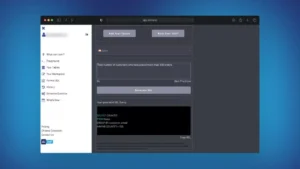Overview
AI code generation, the intersection of artificial intelligence (AI) and programming, has been revolutionizing the world of software development. It refers to the process where AI systems are trained to write code, thereby automating the process of programming. Until recently, this might have seemed like science fiction, but today it’s a reality that is rapidly evolving and shaping the future of software development.
The concept is built upon machine learning algorithms that train on vast datasets of codes. These algorithms learn the common patterns, practices, and conventions in coding and can generate new code based on their learning. Modern code generation tools are based on large language models (LLMs), built on top of the transformer architecture, which are able to generate human-like code, comments, and documentation.
AI code generation is not just about automating processes; it is also about enhancing the quality of human-written code, assisting developers in real time, and making coding accessible to non-technical individuals.
While humans have been writing codes for decades, the idea of AI code generation brings a new dimension to the table. It’s about amplifying human capabilities, reducing the time spent on repetitive coding tasks, and allowing developers to focus on more complex and innovative aspects of software development.
This is part of a series of articles about AI tools for developers
In this article:
- The Significance and Role of AI for Code Generation
- Improving Code Quality
- Real-time Coding Assistance
- Learning and Skill Development
- Increasing Accessibility
- 6 Notable AI Code Generation Tools
- Replit GhostWriter
- GitHub Copilot
- Tabnine
- Cody
- Debuild
- AI2SQL
The Significance and Role of AI for Code Generation
Improving Code Quality
One of the most significant roles AI plays in code generation is improving code quality. By learning from millions of lines of code, AI systems can adopt best practices and avoid common errors. At least in theory, they can generate clean, efficient, and high-quality code, reducing the possibility of bugs and errors.
However, in reality, AI code generation systems based on large, unvetted datasets can learn from the mistakes of the code they train and generate code with quality or security issues. This is why their output must be reviewed by humans.
Therefore, while AI can significantly enhance the software development process, it is essential to have human oversight to ensure the quality and security of the generated code. This collaboration between AI and human developers can lead to more efficient and reliable software development.
Real-time Coding Assistance
Of course! I can help with coding in various programming languages, such as Python, JavaScript, Java, C++, and many more. Whether you need assistance with debugging, algorithm design, or general coding guidance, feel free to ask. Just let me know what you’re working on, and I’ll do my best to assist you in real time.
Real-time coding assistance powered by AI is a game-changer for both novice and experienced programmers. For beginners, it can act as a guiding hand, helping them understand and correct errors while also suggesting best practices. Meanwhile, for seasoned developers, AI can offer fresh perspectives and alternative solutions, ultimately enhancing productivity and the quality of the code produced. This is a clear demonstration of how AI can complement human expertise in the field of software development.
Learn more in our detailed guide to AI code assistant tools
Learning and Skill Development
This can help developers understand the reasoning behind the code and improve their problem-solving skills. Additionally, AI code generation can also help automate repetitive tasks, allowing developers to focus on more complex and creative aspects of their work. Overall, AI code generation can be a valuable tool for supporting learning and skill development in the field of software development.
Increasing Accessibility
Absolutely, the democratization of coding through AI is a game-changer for many industries. By making coding more accessible, AI enables a broader range of individuals to participate in software development, fostering innovation and creativity. This accessibility can lead to a more diverse set of perspectives and ideas being brought to the table, ultimately benefiting the entire tech community.
6 Notable AI Code Generation Tools
Now that we have an understanding of the different types of AI code generation, let’s look at some of the top tools 
Replit GhostWriter is an AI-powered code generation tool that is gaining popularity among developers. It generates code by predicting what a developer might want to write next. This prediction is based on the context of the existing code and the patterns identified in millions of public code repositories. GhostWriter not only predicts the next line of code but can also complete entire functions.
Replit GhostWriter is a versatile tool that supports multiple programming languages, including Python, JavaScript, and Java. Additionally, it is integrated into the Replit browser-based IDE, making it accessible to any user with a Replit account.
2. GitHub Copilot

GitHub Copilot is indeed a groundbreaking tool that has revolutionized the coding experience for developers. Its integration with GitHub and Visual Studio Code has made it a popular choice among developers, and its ability to suggest and generate code based on natural language prompts has significantly expedited the coding process. The utilization of Codex, an advanced AI system trained on public code repositories, enables GitHub Copilot to comprehend diverse coding styles and patterns across a wide range of programming languages. Overall, GitHub Copilot has significantly enhanced the efficiency and productivity of developers worldwide.
3. Tabnine

Tabnine sounds like a powerful tool for developers. Its use of machine learning and integration with various code editors make it a versatile and valuable asset for coding projects. If you have any specific questions about Tabnine or its capabilities, feel free to ask!
4. Cody

Cody is yet another AI code-generation tool. What sets Cody apart is its ability to understand the intent behind the code. This deep understanding allows it to generate code that is not only functional but also efficient and in line with best coding practices.

A key feature of Cody is its ability to learn from previous code and improve over time. This allows the tool to learn from its mistakes and generate better code with each iteration.
Cody is designed to integrate seamlessly with existing software development workflows, allowing developers to receive AI assistance without disrupting their workflows.
5. Debuild

Debuild is another AI code generation tool that is designed to help developers build applications faster and more efficiently. It allows developers to describe an app and uses AI to understand its required design and functionality. It then uses this understanding to generate code in various programming languages.

By using Debuild, developers can focus on the higher-level aspects of software development, such as architecture and design, while leaving the tedious task of coding to AI.
6. AI2SQL

AI2SQL can be integrated into existing applications or used as a standalone tool for database management. It supports a wide range of SQL databases, including MySQL, PostgreSQL, SQL Server, and Oracle. By automating the query generation process, developers can save time and reduce the risk of human error. This can lead to faster development cycles and more reliable database operations.
AI2SQL also includes features for optimizing query performance, such as identifying redundant or inefficient code and suggesting improvements. This can help developers create more efficient and scalable database applications.
Overall, AI2SQL is a valuable tool for developers who want to streamline their SQL query development process and improve the performance of their database applications.

AI2SQL requires minimal user input, making it effortless to use. In addition, the SQL queries generated by the tool are optimized for performance, ensuring that they run as efficiently as possible.
Auto-Generating Code Documentation with Swimm
Swimm is a powerful tool that can automatically generate code documentation for your projects. It can analyze your codebase and extract relevant information to create comprehensive and up-to-date documentation.
To use Swimm for auto-generating code documentation, follow these steps:
1. Install Swimm: Start by installing Swimm on your local machine. You can find installation instructions on the Swimm website or in the documentation.
2. Set up your project: Once Swimm is installed, you’ll need to set up your project in Swimm. This involves connecting your code repository (e.g., GitHub, GitLab) to Swimm and configuring the settings for your project.
3. Analyze your code: After setting up your project, Swimm will analyze your codebase to extract relevant information. This includes parsing code comments, function signatures, and other metadata to understand the structure and functionality of your code.
4. Generate documentation: Once the code analysis is complete, Swimm will automatically generate documentation for your project. This documentation will include information about classes, functions, variables, and other elements of your code, along with explanations and examples.
5. Review and update: After the initial documentation is generated, you can review and update it as needed. Swimm provides tools for editing and annotating the documentation, as well as for adding additional context and examples.
6. Keep documentation up-to-date: Swimm can also help you keep your documentation up-to-date as your code changes. It can automatically detect code changes and update the documentation accordingly, ensuring that it remains accurate and relevant.
By using Swimm for auto-generating code documentation, you can save time and effort while ensuring that your documentation is always comprehensive and up-to-date. This can be particularly valuable for large and complex codebases, where maintaining accurate documentation can be a significant challenge.
 Data Science in Digital Marketing Data Science in Digital Marketing: Mechanism Examples, Benefits Data Science Meets Digital Marketing Magic
Data Science in Digital Marketing Data Science in Digital Marketing: Mechanism Examples, Benefits Data Science Meets Digital Marketing Magic



